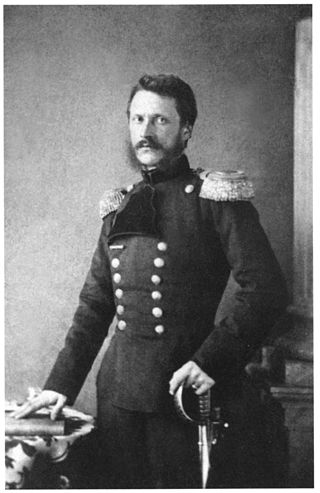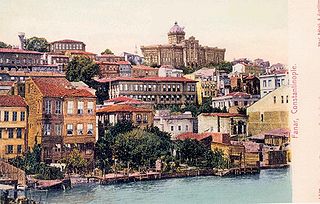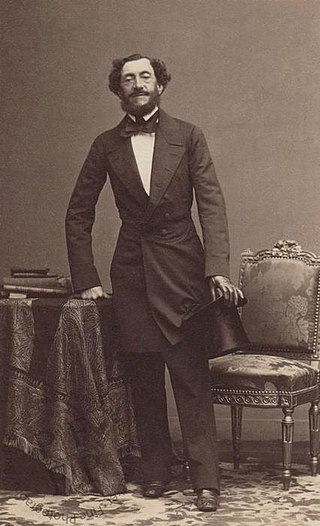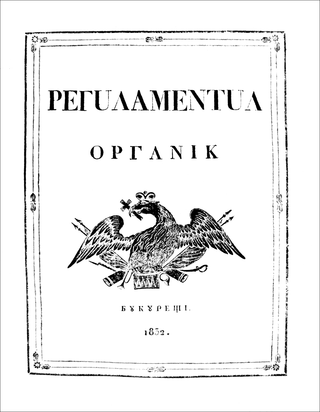
Alexandru Ioan Cuza was the first domnitor (ruler) of the Romanian Principalities through his double election as prince of Moldavia on 5 January 1859 and prince of Wallachia on 24 January 1859, which resulted in the unification of the two states. He was a prominent figure of the Revolution of 1848 in Moldavia. Following his double election, he initiated a series of reforms that contributed to the modernization of Romanian society and of state structures.

Moldavia is a historical region and former principality in Central and Eastern Europe, corresponding to the territory between the Eastern Carpathians and the Dniester River. An initially independent and later autonomous state, it existed from the 14th century to 1859, when it united with Wallachia as the basis of the modern Romanian state; at various times, Moldavia included the regions of Bessarabia, all of Bukovina and Hertsa. The region of Pokuttya was also part of it for a period of time.

Wallachia or Walachia is a historical and geographical region of modern-day Romania. It is situated north of the Lower Danube and south of the Southern Carpathians. Wallachia was traditionally divided into two sections, Muntenia and Oltenia. Dobruja could sometimes be considered a third section due to its proximity and brief rule over it. Wallachia as a whole is sometimes referred to as Muntenia through identification with the larger of the two traditional sections.
The Middle Ages in Romania began shortly after the withdrawal of the Roman legions from the former Roman province of Dacia in the late 3rd century and with the start of the Early Middle Ages and the Migration Period that followed afterwards respectively. It subsequently came to an end with the reign of Domn Michael the Brave (1593–1601) who managed, for a short time between 1599 and 1600, to rule Wallachia, Moldavia, and Transylvania together, the three principalities whose territories were to be united some three centuries later to form modern and contemporary Romania.
The Romanian Old Kingdom is a colloquial term referring to the territory covered by the first independent Romanian nation state, which was composed of the Romanian Principalities: Wallachia and Moldavia. The union of the two principalities was achieved when, under the auspices of the Treaty of Paris (1856), the ad hoc Divans of both countries, which were then under Ottoman Empire suzerainty, voted for Alexander Ioan Cuza as their prince. This process achieved a de facto unification under the name of the United Principalities of Moldavia and Wallachia. The region itself is defined by the result of that political act, followed by the Romanian War of Independence, the inclusion of Northern Dobruja and the transfer of the southern part of Bessarabia to the Russian Empire in 1878, the proclamation of the Kingdom of Romania in 1881, and the annexation of Southern Dobruja in 1913.

Phanariots, Phanariotes, or Fanariots were members of prominent Greek families in Phanar, the chief Greek quarter of Constantinople where the Ecumenical Patriarchate is located, who traditionally occupied four important positions in the Ottoman Empire: Voivode of Moldavia, Voivode of Wallachia, Grand Dragoman of the Porte and Grand Dragoman of the Fleet. Despite their cosmopolitanism and often-Western education, the Phanariots were aware of their Greek ancestry and culture; according to Nicholas Mavrocordatos' Philotheou Parerga, "We are a race completely Hellenic".

The Senate is the upper house in the bicameral Parliament of Romania. It has 136 seats, to which members are elected by direct popular vote using party-list proportional representation in 43 electoral districts, to serve four-year terms.

The Danubian Principalities was a conventional name given to the Principalities of Moldavia and Wallachia, which emerged in the early 14th century. The term was coined in the Habsburg monarchy after the Treaty of Küçük Kaynarca (1774) in order to designate an area on the lower Danube with a common geopolitical situation. The term was largely used then by foreign political circles and public opinion until the union of the two principalities in 1859. Alongside Transylvania, the United Principalities of Moldavia and Wallachia became the basis for the Kingdom of Romania, and by extension the modern nation-state of Romania.

Count Pavel Dmitrievich Kiselyov or Kiseleff is generally regarded as the most brilliant Russian reformer during Nicholas I's generally conservative reign.
The Early Modern Times in Romania started after the death of Michael the Brave, who ruled in a personal union, Wallachia, Transylvania, and Moldavia – three principalities in the lands that now form Romania – for three months, in 1600. The three principalities were subjected to the Ottoman Empire, and paid a yearly tribute to the Ottoman Sultans, but they preserved their internal autonomy. In contrast, Dobruja and the Banat were fully incorporated into the Ottoman Empire.

Barbu Dimitrie Știrbei, also written as Stirbey,, a member of the Bibescu boyar family, was a hospodar on two occasions, between 1848 and 1853, and between 1854 and 1856.

Regulamentul Organic was a quasi-constitutional organic law enforced in 1831–1832 by the Imperial Russian authorities in Moldavia and Wallachia. The document partially confirmed the traditional government and set up a common Russian protectorate which lasted until 1854. The Regulamentul itself remained in force until 1858. Conservative in its scope, it also engendered a period of unprecedented reforms which provided a setting for the Westernization of the local society. The Regulamentul offered the two Principalities their first common system of government.
The Convention of Balta Liman of 1 May 1849 was an agreement between the Russian Empire and the Ottomans regulating the political situation of the two Danubian Principalities, signed during the aftermath of the Revolutions of 1848. Moldavia, which had been placed under Russian occupation in late spring 1848 following a revolutionary attempt, and Wallachia, where a liberal Provisional Government had briefly assumed power before facing a common Ottoman-Russian reaction, were confirmed their previous status of Ottoman suzerainty and Russian protectorate. Minor provisions were added, signifying a relative increase in Ottoman influence—namely, hospodars were no longer elected by the local National Assemblies for life, and instead appointed by the Sublime Porte for seven-year terms. A common military presence was maintained until 1851. The document led to the appointment of Barbu Dimitrie Ştirbei as hospodar of Wallachia and Grigore Alexandru Ghica as hospodar of Moldavia. The Convention was rendered void by the Crimean War, and the statutory system itself was annulled by the 1856 Treaty of Paris.

Prince Nicolae Vogoride, was a caimacam who ruled Moldavia between 1857–1858, following the Crimean War.

The Akkerman Convention was a treaty signed on October 7, 1826, between the Russian and the Ottoman Empires in the Budjak citadel of Akkerman. It imposed that the hospodars of Moldavia and Wallachia be elected by their respective Divans for seven-year terms, with the approval of both Powers. It also provided for the retreat of Ottoman forces from both Danubian Principalities after their prolonged stay following military actions in 1821, and Tudor Vladimirescu's uprising. The Ottomans also agreed to cede to Wallachia the control over the Danube ports of Giurgiu, Brăila and Turnu. The convention also tackled the Serbian question: in article 5, autonomy for the Principality of Serbia was given, and the return of lands removed in 1813. Serbs were also granted freedom of movement through the Ottoman Empire.

Chattel Slavery existed on the territory of present-day Romania from the founding of the principalities of Wallachia and Moldavia in 13th–14th century, until it was abolished in stages during the 1840s and 1850s before the Romanian War of Independence and the formation of the United Principalities of Moldavia and Wallachia in 1859, and also until 1783 in Transylvania and Bukovina. Most of the slaves were of Romani ethnicity. Particularly in Moldavia there were also slaves of Tatar ethnicity, probably prisoners captured from the wars with the Nogai and Crimean Tatars.

Romania–Russia relations are the foreign relations between Romania and Russia. Romania has an embassy in Moscow and consulates-general in Rostov-on-Don and Saint Petersburg. Russia has an embassy in Bucharest and a consulate-general in Constanţa. Historical relations have oscillated among grudging cooperation, neutrality, open hatred and hostility.

The United Principalities of Moldavia and Wallachia, commonly called United Principalities or Wallachia and Moldavia, was the personal union of the Principality of Moldavia and the Principality of Wallachia. The union was formed 5 February [O.S. 24 January] 1859 when Alexandru Ioan Cuza was elected as the Domnitor of both principalities. Their separate autonomous vassalage in the Ottoman Empire continued with the unification of both principalities. On 3 February [O.S. 22 January] 1862, Moldavia and Wallachia formally united to create the Romanian United Principalities, the core of the Romanian nation state.

Elections for the ad hoc Divan were held in Wallachia in September 1857. They restored a liberalizing trend that had been repressed following the 1848 revolution, also giving expression to the national awakening that was taking part among the Romanians. The toppling of the conservative Regulamentul Organic regime in both Danubian Principalities made them possible: following the 1856 Treaty of Paris, Wallachia and Moldavia functioned as a protectorates of the European powers; both were also clients of the Ottoman Empire. Excluding the spontaneous rallies of 1848, this was the first public consultation to be held in eleven years. It ran in conjunction with the Moldavian Divan elections, and, like them, had unusually lax criteria for participation, allowing peasants and guilds to vote by indirect suffrage.

Elections for the princely throne of Wallachia were held on December 20–21, 1842, marking the start of Gheorghe Bibescu's rule. They were the first of two such elections ever held in Wallachia, and historic in that they restored and modernized the elective monarchy, after a 112-year hiatus. While earlier elections took place under the Vlach law, the 1842–43 race was held under a modernized suffrage: there were multiple candidates, an electoral college, approval voting, and exhaustive ballot. The selection of voters extended beyond the inner circle of the Wallachian boyars, with consultation of the provincial landowners and the guilds. Such practices reflected the modernizing trend instituted by the Regulamentul Organic regime in both Danubian Principalities, under the shared custody of the Russian and Ottoman empires. In Moldavia, however, the regime did not permit princely elections, making Bibescu's the only Regulamentul reign to have been consecrated by a vote.
















